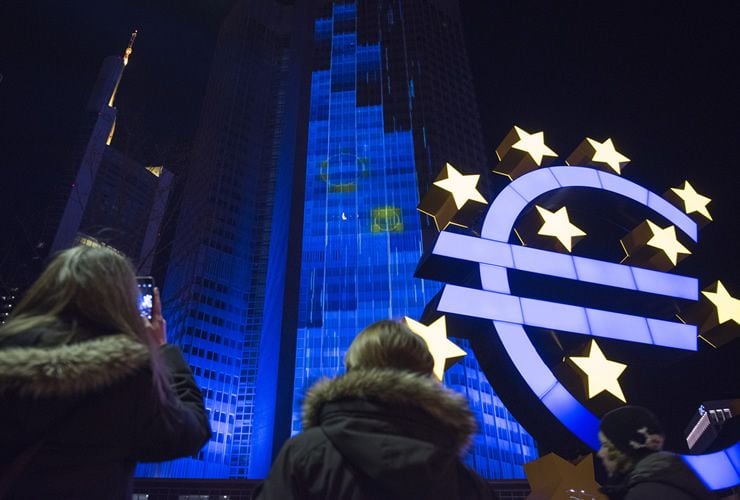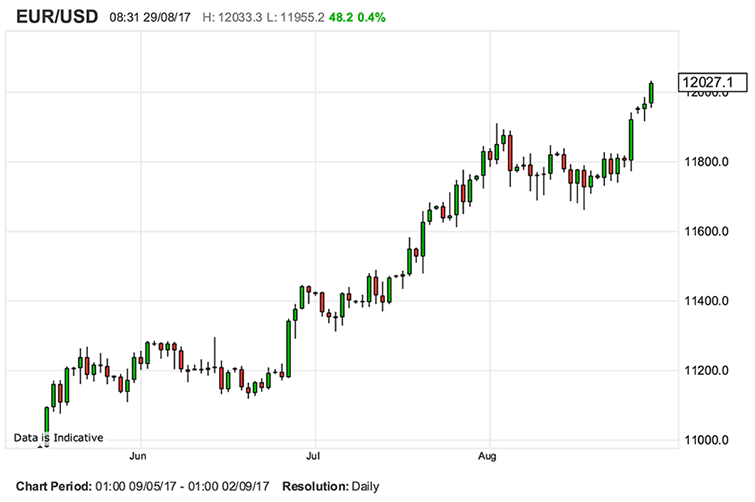EUR/USD Exchange Rate Breaks 1.20, Surge Towards 1.25 Now Possible
- Written by: Gary Howes

The Euro broke above the 1.20 v the US Dollar for the first time since the start of 2015 as positive momentum combines with a broad-based soft US Dollar sentiment.
The Euro to Dollar exchange rate (EUR/USD) hit 1.2026 as volumes lifted after London markets began trading after an extended weekend.

The Dollar was seen underperforming as safe-haven flows increased as news has broken of a seriously provocative move by North Korea that looks to flare up the geopolitical risk once more.
A ballistic missile was launched and flew over Japan in an “unprecedented, serious and significant” threat, according to Japanese Prime Minister Shinzo Abe.
“This will surely provoke a response from US President Trump who previously suggested the US would react with “fire and fury” at any escalation of threat. This move has impacted financial markets, with risk appetite being hit. The main safe haven trades, such as gold, US Treasuries and the yen have all strengthened, whilst the US dollar and equities have been casualties,” says Richard Perry, a trader with Hantec Markets.
It is however worth pointing out that the Euro has not necessarily enjoyed similar strength against the Pound which is itself looking heavily oversold and also taking advantage of a weaker Dollar.
EUR/USD Rally is Likely to Extend
Most technical analysts are maintaining the mantra that ‘the trend is your friend’ and the EUR/USD should head higher still.
“A period of consolidation has come to an end, with the market choosing to break in the direction of the trend, pushing to fresh 2017 and +2.5 year highs. The bullish move could now open the door for an acceleration towards the 1.2150 area, a measured move extension projection following this latest 250 point consolidation, mostly between 1.1900 and 1.1700,” says a note from LMAX Exchange.
Analyst Kathy Lien at BK Asset Management thinks EUR/USD could hit 1.22 and possibly even 1.25:
“The longer target is a stretch but realistically, above 1.20, there is no technical resistance for EUR/USD until 1.25.
“Historically, 1.25 still puts the pair less than halfway between its 2008 1.6038 high and last year's 1.0352 low. Also the 5-year average value of EUR/USD is around 1.21, so 1.25 would not be a significant overvaluation.”
Another key driver of the Euro appears to the reluctance of the European Central Bank to talk the currency lower.
There are concerns that the rising value of the Euro might soon start to dampen economic performance in the Eurozone.
ECB Governor Draghi had the opportunity to talk down the currency on Friday at Jackson Hole but he chose not to do so and in saying nothing, “he effectively gave EUR/USD bulls his blessing to take the currency higher,” says Lien.
“So in the 1.5 weeks between now and September 7th, EUR/USD will be trading with an upward bias unless the ECB steps in and expresses concern about the level of the currency,” adds the analyst.
Strategists at CIBC meanwhile report the post-Jackson Hole breakout higher in EUR/USD price action has taken the exchange rate to a target at the 1.2050 mark for a profit of 8.90%.
"To be clear, we still favour EUR/USD upside in the months to come. Expectations of an ECB policy shift have been built into the EUR to a meaningful degree, but market expectations of a deposit rate hike before the middle of next year (at 1bp) are still underpriced," says CIBC strategist Bipan Rai.
For now, Rai is happy to wait for better levels to re-load on EUR/USD longs or to add to positions on EUR crosses
This Trade Might be Overdone
As mentioned, the Euro’s current bout of strength was triggered by following speeches delivered by European Central Bank President Mario Draghi and Federal Reserve Chair Janet Yellen at the Economic Symposium held in Jackson Hole, Wyoming ahead of the weekend.
“The explanation is simple: Draghi offered some information, Yellen none. Although Draghi’s luncheon address did not cause the sandwiches to stick in his listeners’ throats, he did confirm that there will eventually be an end to the ECB’s asset purchase programme,” says David A. Meier, Economist, with Julius Baer in Switzerland.
Draghi stressed nevertheless that the normalisation of the ECB’s expansive monetary policy will be very slow due to lagging inflation.
Furthermore, he did not voice any concerns about the currently strong euro levels.
“This was the key item that markets jumped upon, as they now do not expect euro strength to hinder the ECB in policy normalisation, ignoring the warnings that it will be a slow process,” says Meier.
Meier is however concerned that markets are getting ahead of themselves when it comes to this ongoing ECB trade.
“We continue to believe that current euro strength expresses exaggerated speculation on ECB monetary policy normalisation, while we still expect a Fed rate hike in December, based on cyclical strength and a recovery in inflation ahead. Euro euphoria should ebb off while higher rates support the dollar, explaining our EUR/USD three-month forecast of 1.12,” says Meier.




